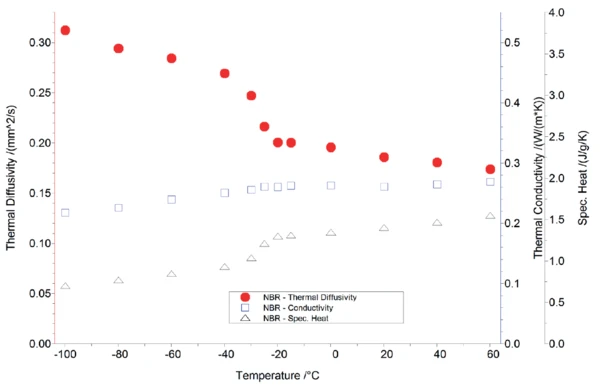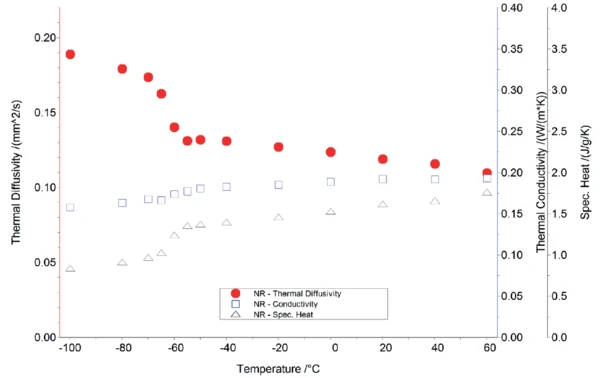Introduction
For elastomers, it is often the case that information is needed about the thermophysical properties below room temperature. The LFA 467 HyperFlash® can cover a temperature range of -100°C to 500°C with only one furnace.
The following measurements show the Conduttività TermicaThermal conductivity (λ with the unit W/(m•K)) describes the transport of energy – in the form of heat – through a body of mass as the result of a temperature gradient (see fig. 1). According to the second law of thermodynamics, heat always flows in the direction of the lower temperature.thermal conductivity of two elastomers (NBR and NR) which were investigated between -100°C and 60°C. For measurements in the low-temperature range (T < 0°C), the MCT detector (mercury-cadmium-telluride) and the CC300 cooling system are needed; however, no modifications to the furnace are necessary. The Specific Heat Capacity (cp)Heat capacity is a material-specific physical quantity, determined by the amount of heat supplied to specimen, divided by the resulting temperature increase. The specific heat capacity is related to a unit mass of the specimen.specific heat capacity was determined by means of the DSC 204 F1 Phoenix®.
Figure 1 shows the Specific Heat Capacity (cp)Heat capacity is a material-specific physical quantity, determined by the amount of heat supplied to specimen, divided by the resulting temperature increase. The specific heat capacity is related to a unit mass of the specimen.specific heat capacity of both samples. Typical for elastomers, the Temperatura di transizione vetrosaLa transizione vetrosa è una delle più importanti proprietà chimico-fisiche dei materiali amorfi e semi-cristallini, come, ad esempio, vetri, metalli (amorfi), polimeri, ingredienti farmaceutici e alimentari e definisce l’intervallo di temperatura in cui le proprietà meccaniche die materiali variano da duro e fragile a più morbido, malleabile o gommoso.glass transition was below RT (NR = -60.9°C; NBR = -26,8°C). The thermophysical properties of the elastomers are depicted in figures 2 and 3. The glass transition can be identified by means of the decrease in Diffusività TermicaThermal diffusivity (a with the unit mm2/s) is a material-specific property for characterizing unsteady heat conduction. This value describes how quickly a material reacts to a change in temperature.thermal diffusivity. The thermal conductivity, on the other hand, increases with increasing temperature almost linearly and exhibits no significant step.


